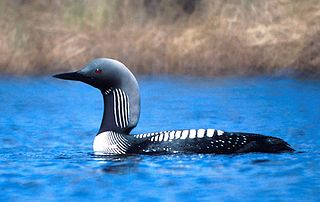
Gaviiformes is an order of aquatic birds containing the loons or divers and their closest extinct relatives. Modern gaviiformes are found in many parts of North America and northern Eurasia, though prehistoric species were more widespread.

Diprotodontia is the largest extant order of marsupials, with about 155 species, including the kangaroos, wallabies, possums, koala, wombats, and many others. Extinct diprotodonts include the hippopotamus-sized Diprotodon, and Thylacoleo, the so-called "marsupial lion".
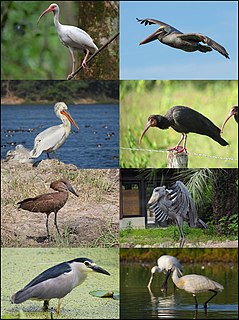
The Pelecaniformes are an order of medium-sized and large waterbirds found worldwide. As traditionally—but erroneously—defined, they encompass all birds that have feet with all four toes webbed. Hence, they were formerly also known by such names as totipalmates or steganopodes. Most have a bare throat patch, and the nostrils have evolved into dysfunctional slits, forcing them to breathe through their mouths. They also have a pectinate nail on their longest toe. This is shaped like a comb and is used to brush out and separate their feathers. They feed on fish, squid, or similar marine life. Nesting is colonial, but individual birds are monogamous. The young are altricial, hatching from the egg helpless and naked in most. They lack a brood patch.

The rails, or Rallidae, are a large cosmopolitan family of small- to medium-sized, ground-living birds. The family exhibits considerable diversity and includes the crakes, coots, and gallinules. Many species are associated with wetlands, although the family is found in every terrestrial habitat except dry deserts, polar regions, and alpine areas above the snow line. Members of the Rallidae occur on every continent except Antarctica. Numerous island species are known. The most common rail habitats are marshland and dense forest. They are especially fond of dense vegetation.
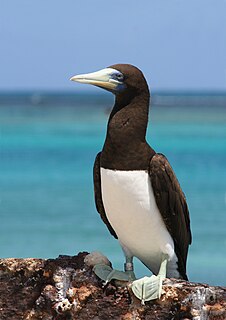
The bird family Sulidae comprises the gannets and boobies. Collectively called sulids, they are medium-large coastal seabirds that plunge-dive for fish and similar prey. The 10 species in this family are often considered congeneric in older sources, placing all in the genus Sula. However, Sula and Morus (gannets) can be readily distinguished by morphological, behavioral, and DNA sequence characters. Abbott's booby (Papasula) is given its own genus, as it stands apart from both in these respects. It appears to be a distinct and ancient lineage, maybe closer to the gannets than to the true boobies.
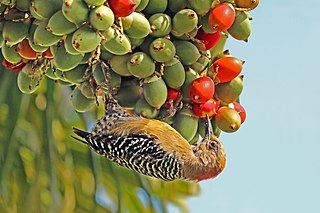
Nine families of largely arboreal birds make up the order Piciformes, the best-known of them being the Picidae, which includes the woodpeckers and close relatives. The Piciformes contain about 71 living genera with a little over 450 species, of which the Picidae make up about half.
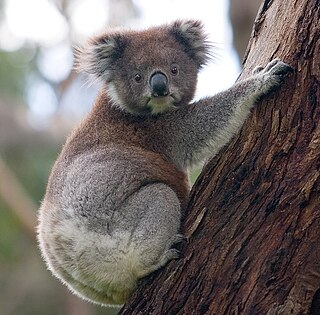
The Phascolarctidae is a family of marsupials of the order Diprotodontia, consisting of only one extant species, the koala, and six well-known fossil species, with another five less well known fossil species, and two fossil species of the genus Koobor, whose taxonomy is debatable but are placed in this group. The closest relatives of the Phascolarctidae are the wombats, which comprise the family Vombatidae.

The Vombatiformes are one of the three suborders of the large marsupial order Diprotodontia. Seven of the nine known families within this suborder are extinct; only the families Phascolarctidae, with the koala, and Vombatidae, with three extant species of wombat, survive.

Musk deer can refer to any one, or all seven, of the species that make up Moschus, the only extant genus of the family Moschidae. Despite being commonly called deer, they are not true deer belonging to the family Cervidae, but rather their family is closely related to Bovidae, the group that contains antelopes, bovines, sheep, and goats. The musk deer family differs from cervids, or true deer, by lacking antlers and preorbital glands also, possessing only a single pair of teats, a gallbladder, a caudal gland, a pair of canine tusks and—of particular economic importance to humans—a musk gland.
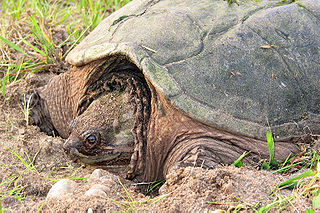
The Chelydridae is a family of turtles that has seven extinct and two extant genera. The extant genera are the snapping turtles, Chelydra and Macrochelys. Both are endemic to the Western Hemisphere. The extinct genera are Acherontemys, Chelydrops, Chelydropsis, Emarginachelys, Macrocephalochelys, Planiplastron, and Protochelydra.
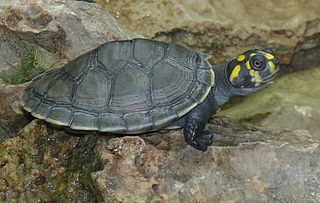
Podocnemididae is a family of pleurodire (side-necked) turtles, once widely distributed. Most of its 20 genera and 30 species are now extinct. Seven of its eight surviving species are native to South America: the genus Peltocephalus, with only one species ; and the genus Podocnemis, with six living species of South American side-necked river turtles. There is also one genus native to Madagascar: Erymnochelys, the Madagascan big-headed turtle, whose single species E. madagascariensis.

Ground squirrels are members of the squirrel family of rodents (Sciuridae), which generally live on or in the ground, rather than trees. The term is most often used for the medium-sized ground squirrels, as the larger ones are more commonly known as marmots or prairie dogs, while the smaller and less bushy-tailed ground squirrels tend to be known as chipmunks. Together, they make up the "marmot tribe" of squirrels, Marmotini, a division within the large and mainly ground squirrel subfamily Xerinae, and containing six living genera. Well-known members of this largely Holarctic group are the marmots (Marmota), including the American groundhog, the chipmunks, the susliks (Spermophilus), and the prairie dogs (Cynomys). They are highly variable in size and habitus, but most are remarkably able to rise up on their hind legs and stand fully erect comfortably for prolonged periods. They also tend to be far more gregarious than other squirrels, and many live in colonies with complex social structures. Most Marmotini are rather short-tailed and large squirrels. At up to 8 kg (18 lb) or more, certain marmots are the heaviest squirrels.

Anseranatidae, the magpie-geese, is a biological family of waterbirds. The only living species, the magpie goose, is a resident breeder in northern Australia and in southern New Guinea.

Glis is a genus of rodent that contains two extant species, both known as edible dormice or fat dormice: the European edible dormouse (Glis glis) and the Iranian edible dormouse. It also contains a number of fossil species.

Squalodon is an extinct genus of whales of the Oligocene and Miocene epochs, belonging to the family Squalodontidae. Named by Jean-Pierre Sylvestre de Grateloup in 1840, it was originally believed to be an iguanodontid dinosaur but has since been reclassified. The name Squalodon comes from Squalus, a genus of shark. As a result, its name means "shark tooth". Its closest modern relative is the South Asian river dolphin.

Albatrosses, of the biological family Diomedeidae, are large seabirds related to the procellariids, storm petrels, and diving petrels in the order Procellariiformes. They range widely in the Southern Ocean and the North Pacific. They are absent from the North Atlantic, although fossil remains show they once occurred there and occasional vagrants are found. Albatrosses are among the largest of flying birds, and species of the genus Diomedea have the longest wingspans of any extant birds, reaching up to 3.7 m (12 ft). The albatrosses are usually regarded as falling into four genera, but disagreement exists over the number of species.
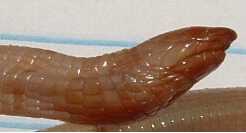
Rhineuridae is a family of amphisbaenians that includes one living genus and species, Rhineura floridana, as well as many extinct species belonging to both Rhineura and several extinct genera. The living R. floridana is found only in Georgia and Florida, but extinct species ranged across North America, some occurring as far west as Oregon. The family has a fossil record stretching back 60 million years to the Paleocene and was most diverse in the continental interior during the Eocene and Oligocene.
The Macropodidae are an extant family of marsupial with the distinction of the ability to move bipedally on the hind legs, sometimes by jumping, as well as quadrupedally. They are herbivores, but some fossil genera like Ekaltadeta are hypothesised to have been carnivores. The taxonomic affiliations within the family and with other groups of marsupials is still in flux.

Neurosymploca? oligocenica is an extinct species of moth in the family Zygaenidae, and possibly in the modern genus Neurosymploca. The species is known from Early Oligocene, Rupelian stage, lake deposits near the commune of Céreste in the Alpes-de-Haute-Provence, France.
Kuphus is a genus of shipworms, marine bivalve molluscs in the family Teredinidae. While there are four extinct species in the genus, the only extant species is Kuphus polythalamius. It is the longest bivalve mollusc in the world, where the only known permanent natural habitat is Kalamansig, Sultan Kudarat in the Philippines.



















